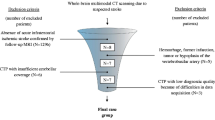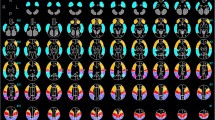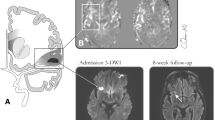Abstract
Transient ischaemic attacks (TIAs) are heterogeneous from the clinical, physiopathological, aetiological and prognostic points of view. Single-photon emission tomography (SPET) may influence patient management by helping to define the vascular topography and by suggesting the probable mechanism (embolic or haemodynamic). However, the variables predicting focal regional cerebral blood flow (rCBF) and cerebrovascular reserve (CVR) abnormalities on SPET and their clinical correlation are poorly known. Our objective in this study was to assess the value of rCBF and CVR measured by SPET in a prospective series of 42 patients with recent (within the preceding 30 days) first-ever TIA Two SPET examinations [baseline and post-acetazolamide (ACZ)] were consecutively performed, and region/reference ratios were obtained using an irregular region of interest (ROI) method. Percentages of interhemispheric asymmetry between homologous brain regions were used to identify abnormalities on baseline SPET, and the percentage changes in asymmetry between the baseline and post-ACZ SPET studies were used to identify abnormal responses to the vasodilator stimulus. Mean baseline and test-retest values previously obtained in normals were used as a reference. The relationship of SPET findings with clinical data and results of complementary examinations was assessed. Most patients (98%) had abnormal findings on either baseline (43%), post-ACZ (19%) or both SPET studies (36%). Thus, 33 patients had hypoperfusion on baseline SPET (78.5%, symptom related in 45%). In 23 patients, a poor response to ACZ was found (55%, symptom related in 21.5%). No predictors for rCBF or CVR impairment were found. Most patients with a first-ever TIA episode present focal hypoperfusion on SPET, either with or without correlation with TIA symptoms. Post-ACZ SPET increases the probability of finding cerebrovascular abnormalities, and orients attention towards an haemodynamic compromise. Focal hypoperfusion on SPET should not be viewed as clinically insignificant because it probably reflects previous or ongoing clinical and/or subclinical episodes of cerebral ischaemia.
Similar content being viewed by others

Author information
Authors and Affiliations
Additional information
Received 25 April and in revised form 31 August 2001
Electronic Publication
Rights and permissions
About this article
Cite this article
Martí-Fàbregas, J., Catafau, A.M., Marí, C. et al. Cerebral perfusion and haemodynamics measured by SPET in symptom-free patients with transient ischaemic attack: clinical implications. Eur J Nucl Med 28, 1828–1835 (2001). https://doi.org/10.1007/s00259-001-0656-6
Published:
Issue Date:
DOI: https://doi.org/10.1007/s00259-001-0656-6



